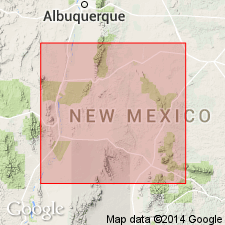
- Usage in publication:
-
- Ojo Huelos Member
- Modifications:
-
- Named
- Dominant lithology:
-
- Limestone
- Mudstone
- AAPG geologic province:
-
- San Juan basin
- Orogrande basin
Summary:
Named as a member of the San Pedro Arroyo Formation of Chinle Group for Ojo Huelos a spring in the Hubbell fault zone of Valencia Co., NM in the San Juan basin. Can be recognized from Carrizo Spring in Valencia Co. south to Carthage in Socorro Co. (Orogrande basin), a distance of about 100 km. "At its type section" [not specifically identified], the member is 7.4+ m thick. Ranges between 1.6 and 7.4+ m thick regionally. Consists of 3 prominent limestone beds separated by yellow-gray mudstone. The limestones range from gray micrite to yellow pisolite. The uppermost sandy mudstone and limestone at the "type" has fossil ostracodes and vertebrates indicative of Late Triassic or late Carnian age. The top of the Ojo Huelos not exposed at its "type". Therefore, nature of upper contact not known. Overlies lower member of Chinle, and is equivalent to the upper part of the lower member of Chinle locally. Section 6.8 m thick measured in N1/2 NE 1/4 sec. 7, T 6 N, R2 W, Carrizo Arroyo, Valencia Co. where member overlies the lower member of the San Pedro Arroyo Formation and consists of basal orange, coarsely crystalline limestone with a few quartzite pebbles, overlain in sequence by: a blue, white, gray nodular limestone; blue to purple bentonitic, calcareous mudstone; and an upper gray micritic limestone [No overlying part of San Pedro Arroyo indicated.] Regional evidence suggests it is overlain by siltstone or mudstone of the upper member of the San Pedro Arroyo. Lacustrine origin suggested. Outcrop distribution suggests deposition in single or separate lakes. Cross section. Correlations charts. Correlates with upper part of the Blue Mesa Member of Chinle of west-central NM and with upper part of Garita Creek Formation of central NM.
Source: GNU records (USGS DDS-6; Denver GNULEX).
For more information, please contact Nancy Stamm, Geologic Names Committee Secretary.
Asterisk (*) indicates published by U.S. Geological Survey authors.
"No current usage" (†) implies that a name has been abandoned or has fallen into disuse. Former usage and, if known, replacement name given in parentheses ( ).
Slash (/) indicates name conflicts with nomenclatural guidelines (CSN, 1933; ACSN, 1961, 1970; NACSN, 1983, 2005, 2021). May be explained within brackets ([ ]).

